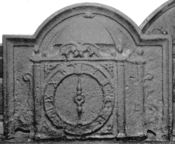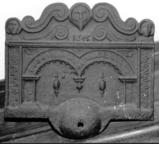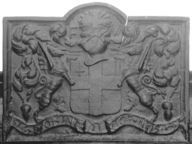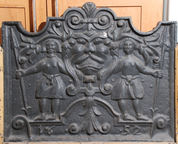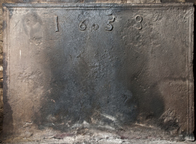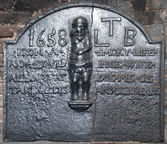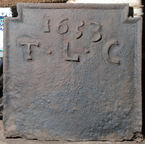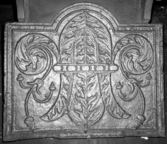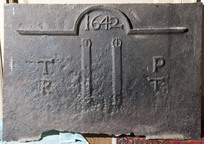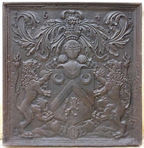-
119
Description: Arched rectangular shape; cavetto moulded edge on all sides; perspective view of a lantern clock.
Notes: The arms of the Worshipful Company of Clockmakers were granted in 1672: Sable a Clock each of the four pillars of the case based on a Lion couchant and capped with a Globe surmounted by a Cross and on the dome of the case an Imperial Crown all Or. The hands of the clock show six o’clock, as on the livery company shield. Formerly part of the Ade Collection (from Grove Hill, Hellingly, Sussex).
Copies of this fireback are known.
- Decoration tags:
- rectangular with round arch (shape)
- cavetto (edging)
- whole carved pattern
- objects
Manufactured: in the mid-17th century in the Weald area of England.
Current location: Hastings Museum and Art Gallery, John's Place, Bohemia Road, Hastings, East Sussex, England.
Museum number: HASMG: 1952.51.48 (LA 776) (part of the Hastings Museum museum group)
- Attached to series:
- Small cavetto series
- Livery company firebacks
-
123
Description: Rectangular; top panel with bearded face between symmetrical horizontal scrolls, and faces at either end; scrolls are repeated below, on either side of the date, all above a horizontal double fillet; below, a pair of arches with guilloche decoration between fillets, and toothed on the underside, are supported on each side by Tuscan columns, also with guilloche decoration; this is repeated in symmetrical rectangular panels on either side; at the centre base a bulbous nozzle protrudes.
Notes: This is a smith's forge fireback, the nozzle being the tuyere directing the air into the fire from bellows behind. Stylistically similar to the Lenard and other firebacks of the same period, the carved elements above the nozzle may have been cast from a pattern inspired by the back of a joined 'wainscot' chair, with the date inserted. The back may have been used for forging non-ferrous metals as there was a trade in pot-founding in bronze as well as iron at some ironworks in the Weald. Formerly part of the Ade Collection (from Grove Hill, Hellingly, Sussex).
Inscription: 1655
- Decoration tags:
- rectangular with round arch (shape)
- fillet (edging)
- whole carved pattern
- individual numbers
- architectural
- text
- humans
Manufactured: in 1655 in the Weald area of England.
Current location: Hastings Museum and Art Gallery, John's Place, Bohemia Road, Hastings, East Sussex, England.
Museum number: HASMG: 1952.51.62 (part of the Hastings Museum museum group)
Citation: Butterfield, W. R., 1916, 'Old Wealden Firebacks', The Connoisseur, 46, pp. 197-209.
- Attached to series:
- Chair pattern firebacks
- Furniture stamp firebacks
-
146
Description: Arched rectangular shape; cavetto moulded edging; shield, helm, crest, supporters, mantling and motto of the Corporation of the City of London; initials split by crest; date split at ends of motto.
Notes: Shield: Argent, a cross gules, in the first quarter a sword in pale point upwards of the last; crest: on a wreath argent and gules a dragon's sinister wing argent, charged on the underside with a cross throughout gules; supporters: on either side a dragon argent charged on the undersides of the wings with a cross throughout gules; motto: Domine Dirige Nos - Lord Direct Us; the earliest illustration of the arms in this form was in 1609, but their use is older. Formerly part of the Ade Collection (from Grove Hill, Hellingly, Sussex).
Copies of this fireback are known.
Inscription: F W / 16 DOMINE DIRIGE NOS 59
Arms: Corporation of the City of London
- Decoration tags:
- rectangular with round arch (shape)
- cavetto (edging)
- whole carved pattern
- individual letters
- armorial
- text
Manufactured: in 1659 possibly in the Weald area of England.
Current location: Hastings Museum and Art Gallery, John's Place, Bohemia Road, Hastings, East Sussex, England.
Museum number: HASMG: 1952.51.53 (part of the Hastings Museum museum group)
- Attached to series:
- Civic firebacks
-
171
Description: Quasi-rectangular with raised symmetrical scrolls between semi-circular re-entrants on top edge; ovolo-moulded edge on bottom and sides, with fillet edging on top; grotesque face with swirled hair locks, above an inverted floral spike, between two moustachioed male figures in tunics, holding pikes, standing on a cavetto-moulded compartment, date beneath.
Notes: Alleged to represent the 'Brede Ogre', Sir Goddard Oxenbridge (1478-1531) who, legend states, was sawn in half by local children. Stylistically similar to other firebacks with connections with Brede furnace.
Copies of this fireback are known.
Inscription: 16 52
- Decoration tags:
- rectangular with ornate arch (shape)
- fillet (edging)
- whole carved pattern
- individual numbers
- pictorial
- text
- humans
Manufactured: in 1652 probably at Brede Furnace in the Weald area of England.
Current location: Hastings Museum and Art Gallery, John's Place, Bohemia Road, Hastings, East Sussex, England.
Museum number: HASMG: 1924.42 (part of the Hastings Museum museum group)
Citation: Baines, J. M., 1958, Wealden Firebacks (Hastings Museum).
Citation: Butterfield, W. R., 10 Mar 1934, 'The Brede Ogre', Hastings and St Leonards Observer.
- Attached to series:
- Hooked '1' series
- Brede group
-
950
Description: Rectangular shape; ovolo-moulded edging (top and sides); date top centre.
Notes: The style of the numerals is identical to those seen on another fireback, indicating a common source.
Inscription: 1658
- Decoration tags:
- rectangular (shape)
- ovolo (edging)
- carved stamps
- individual numbers
- text
Manufactured: in 1658 possibly at Tintern Furnace in the Forest of Dean area of Wales.
Current location: in private hands, Horsted Keynes, West Sussex, England.
- Attached to series:
- Date only firebacks
- 1640-50s Dean series
-
337
Description: Arched rectangular shaped; ovolo moulded edging (top and sides); central stamp of a carved bracket figure of a bearded man in a loincloth and cap; date and monogram in arch, split by figure, ‘T’ elevated; rhyme in capitals across centre, letters carved on strips, split by figure; date and initials as individual stamps.
Notes: The twin miseries of a smoky house and a scolding wife are mentioned several times in literature. The dress of the figure suggests work as a miner, possibly linking this back with the Forest of Dean. Variants exist without date or initials, or with other dates. A version of this fireback with the date 1660, instead of 1658, was noted at Bellamy's Farm, Longney, Gloucestershire in 1912 (Notes and Queries, 11th ser., 6 (Sep 1912), p.230.).
Copies of this fireback are known.
Inscription: 1658 LTB; ·FROM ·A·-·SMOKY ·LIFE·/ AND·A SCOVL DING·WIFE·/ALL MEN THAT-DOE·ME·SE/ TAKE·PETIE- AND·DELIVER ME
- Decoration tags:
- rectangular with round arch (shape)
- fillet (edging)
- carved stamps
- individual letters
- individual numbers
- text
- humans
Manufactured: in 1658 possibly at Tintern Furnace in the Forest of Dean area of Wales.
Current location: in private hands, Huddington, Worcestershire, England.
Citation: Chambers, L. H., 26 Sep 1912, 'Fireback: Relic of 1660', Notes and Queries, 11th series, 6, p. 230.
-
339
Description: Rectangular with rebated top corners; ovolo moulded edging (top and sides); topcentre, date above initials.
Notes: The rebated corners are an unusual feature.
Inscription: 1653 / T · L ·C
- Decoration tags:
- rectangular (shape)
- ovolo (edging)
- individual letters
- individual numbers
- text
Manufactured: in 1653 in England.
Current location: in private hands, Huddington, Worcestershire, England.
- Attached to series:
- Date & initials firebacks
-
352
Description: Arched rectangular shape; cyma curve and astragal edging; fleur de lys formed from acanthus leaves within a circlet, between swirled, budded fronds, all in bas-relief.
Notes: An uncommon English fireback with a purely floral design.
Copies of this fireback are known.
- Decoration tags:
- rectangular with round arch (shape)
- cyma curve and astragal (edging)
- whole carved pattern
- heraldic
- plants
Manufactured: in the mid-17th century in England.
Current location: Christchurch Mansion, Ipswich, Suffolk, England.
(part of the Colchester & Ipswich Museums Service museum group)
- Attached to series:
- Miscellaneous pattern firebacks
-
1104
Description: Rectangular shape; plain edging (top and sides); full-height impression of a fireback of arched rectangular shape and ovolo edging; date in arch; below arch, two parallel straps, each with a buckle at the top; initials T above R to the left of centre, and P above T to the right.
Notes: The side edging of the original fireback has been erased before casting. A variant of the 1642 series of firebacks bearing the Pelham buckle badge and the initials TP, believed to relate to Sir Thomas Pelham (1597-1654). It is not known to whom the initials RT relate; their style suggests they are contemporary with the original fireback. A larger fireback has been created by impressing either the original pattern of the Pelham fireback or a casting from it into a plain rectangular mould, and modifying it by removing the side moulding. It is unclear whether the additional initials, RT, had already been added to the 'pattern' or were added to this casting.
Inscription: 1642 / T P / R T
- Decoration tags:
- rectangular (shape)
- plain and ovolo (edging)
- whole carved pattern
- individual letters
- individual numbers
- planklines
- text
- objects
Manufactured: in the mid-17th century possibly in the Weald area of England.
Current location: in private hands, Isleworth, London, England.
- Attached to series:
- 1642 Pelham series
- Pelham family firebacks
-
1014
Description: Rectangular with moulded edging; shield, forward-facing helm, lion's head crest, mantling, lion supporters, and collar of the Order of St Michael
Notes: The arms are probably those of Jean Bouchu (1597-1653), French parliamentarian: azure, a chevron between, in chief, two crescents and, in base, a lion rampant sinister or.
Inscription: 1641
Arms: Bouchu
- Decoration tags:
- rectangular (shape)
- complex individual (edging)
- whole carved pattern
- armorial
- text
Manufactured: in 1641 in France.
Current location: Claude Augustin Antique Materials, 104 Route Nationale 6, 69380 Les Chères, Rhone, France.
- Attached to series:
- Foreign armorial firebacks
